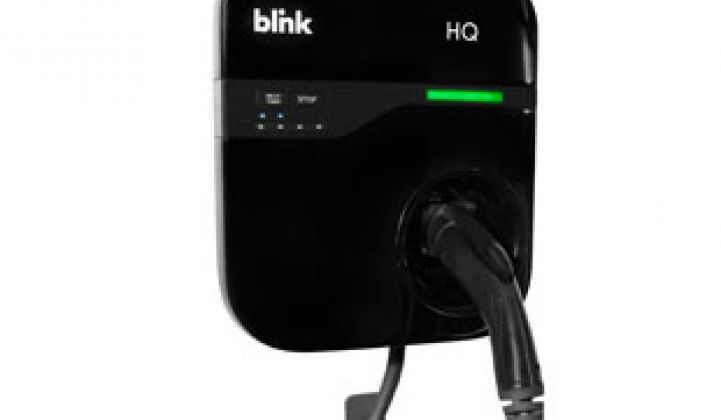For more than three years, ECOtality (NASDAQ: ECTY) has been basking in the warmth of about $100 million federal dollars. Now, as the U.S. Department of Energy’s EV Project winds down, the electric transportation technologies company is back out in the cold, faced with the harsh reality of selling its wares to the people on the open marketplace.
ECOtality introduced a new family of home electric vehicle chargers on Wednesday to compete in the wider market. The charger comes with a membership to the larger Blink charging network and $100 charging credit with purchase. Most of the participants in the EV Project received their Blink chargers at no cost.
The product offerings include two new programmable level 2 home chargers, which can be set to delay charging when rates are lowest. Another charger with remote access capabilities is also coming. The products will be sold online through retailers.
The initial price point is lower than most level 2 chargers at $599, but not as low as Bosch’s $450 offering that recently came to market. The $100 credit is good for six months and can be used at any of the approximately 3,000 public Blink chargers, which are concentrated in about fifteen cities.
“Our premiere line of Blink HQ home charging products offer EV drivers exactly what they’ve been asking for: connection to the Blink Network, freedom to charge at home at their convenience and unprecedented value,” Ravi Brar, CEO of ECOtality, said in a statement.
The question of cost versus software and controls will be sorted out in the market in coming years, as more automakers introduce all-electric and plug-in hybrids into the market. Bosch and ECOtality hover around $500 as an entry point, which is about half of what most level 2 chargers go for today. Other charging companies will likely roll out lower-priced chargers to compete.
Another consideration is relationships with dealerships. AeroVironment (NASDAQ:AVAV) announced earlier this year that its charger can be bundled with Nissan Leaf (NASDAQ:NSANY) at the point of purchase, so the cost can be rolled into financing. ECOtality does not have any deals with carmakers at this point.
ECOtality is hoping that its extensive Blink network will be a selling point for drivers. “Having Blink HQ home charging products in EV drivers’ homes, bundled with a membership, will help support our growth and generate an annuity base as the number of EV drivers grows,” added Brar.
In some regions, it will have to compete with other charging networks, such as NRG’s Freedom Charging network in Texas and another proposed network in California. ECOtality has also partnered with ChargePoint in a joint venture called Collaboratev that will make the two companies’ customer management and RFID card payment systems compatible with one another.
Most of ECOtality’s revenue came from the EV project in 2012, and so the company has an uphill battle to generate sales from paying customers. It hopes there will be enough EV drivers looking for charging networks to ensure that they will seek out the Blink chargers rather than use one of its competitors' chargers, and then will continue using the charging networks for years to come.
A challenge will be the stores and other commercial locations that are putting in free fast chargers to lure EV customers, as Walgreens is doing. If people know the bulk of their charging is happening at home, they might not immediately jump into a charging membership if they think they can get it for free. It is also a bit of a chicken-and-egg conundrum. If enough drivers choose Blink, stores like Kroger could be more apt to choose Blink as a partner for its charging stations (as it already has done).
Home charging is just one portion of ECOtality’s business. The company also has a fast charger for industrial and commercial fleets, called Minit Charger, and an R&D arm, eTec Labs. The new level 2 chargers will be shipped in early summer.



